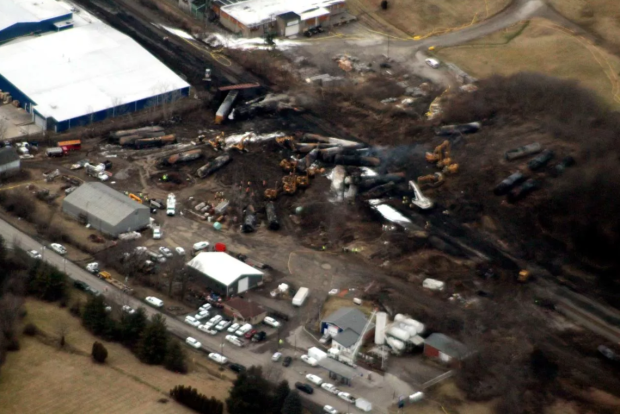Ohio Train Derailment: The Lingering Threat Of Toxic Chemicals In Buildings

Table of Contents
Assessing the Extent of Chemical Contamination in Buildings
Types of Chemicals Involved and Their Potential Impacts
The derailment involved the release of various hazardous chemicals, including vinyl chloride, butyl acrylate, and ethylene glycol monobutyl ether. These chemicals pose significant risks to both human health and the structural integrity of buildings.
- Vinyl chloride: A known carcinogen, vinyl chloride can cause liver damage, respiratory problems, and an increased risk of various cancers with long-term exposure. It can also leach into building materials, making detection and remediation challenging.
- Butyl acrylate: This chemical is an irritant that can cause skin and eye irritation, respiratory problems, and even central nervous system effects with prolonged exposure. Its volatile nature means it can easily permeate building materials.
- Ethylene glycol monobutyl ether: This solvent can cause kidney damage, developmental issues, and reproductive problems with chronic exposure. It can linger in porous materials like drywall and carpeting.
Detecting these chemicals in building materials can be difficult, requiring specialized testing and analysis by qualified professionals. The complexity of the chemical mixture released further complicates assessment efforts.
Pathways of Contamination
The toxic chemicals released from the Ohio train derailment could have entered buildings through several pathways:
- Airborne dispersion: Volatile organic compounds (VOCs) like vinyl chloride can easily disperse in the air and infiltrate buildings through cracks, windows, and ventilation systems.
- Groundwater contamination: Chemicals leaching into the soil can contaminate groundwater, which can then enter buildings through basements or foundations, leading to water damage and further contamination.
- Soil contamination: Direct contact with contaminated soil during cleanup or even through tracked-in dirt can bring chemicals into buildings. Long-term leaching of chemicals from the soil poses a continued threat.
Health Risks Associated with Long-Term Exposure
Acute vs. Chronic Health Effects
Exposure to the chemicals released in the Ohio train derailment can cause a range of health problems, both immediate and long-term.
- Acute effects: These include immediate symptoms such as skin irritation, respiratory distress, nausea, and headaches.
- Chronic effects: Long-term exposure can lead to more severe health consequences, including cancer, liver damage, kidney disease, reproductive issues, and neurological disorders. The latency period for chronic symptoms to manifest can be years, making early detection crucial.
Vulnerable Populations
Certain populations are particularly vulnerable to the health risks associated with chemical exposure from the Ohio train derailment:
- Children: Their developing bodies are more susceptible to the harmful effects of toxic chemicals.
- Elderly: Pre-existing health conditions can exacerbate the impact of chemical exposure.
- Individuals with pre-existing respiratory or cardiovascular conditions: These individuals are at higher risk of experiencing severe health complications.
Targeted health monitoring and support are crucial for these vulnerable populations in the affected area. Long-term health studies are needed to fully understand the consequences of this disaster.
Mitigation and Remediation Strategies for Contaminated Buildings
Testing and Assessment Procedures
To determine the extent of chemical contamination, comprehensive testing and assessment are essential:
- Air quality tests: These measure the concentration of VOCs and other harmful chemicals in the air.
- Water sampling: This identifies the presence and concentration of chemicals in groundwater and potable water sources.
- Material analysis: This involves testing building materials (e.g., drywall, insulation, flooring) for chemical penetration.
Engaging professional environmental remediation companies with expertise in handling hazardous materials is crucial for accurate assessment and effective remediation.
Remediation Techniques
Various remediation techniques may be necessary depending on the level and type of contamination:
- Air scrubbing: This involves using specialized equipment to remove harmful chemicals from the air within buildings.
- Soil removal: Contaminated soil may need to be excavated and replaced.
- Building demolition: In cases of severe and pervasive contamination, demolition may be the only feasible option.
The cost and feasibility of different remediation approaches will vary depending on the extent of contamination and the specific building materials involved.
Legal and Regulatory Implications
Responsibility and Liability
Determining the legal responsibility for the cleanup and compensation for damages is a complex process:
- Norfolk Southern Railway: As the operator of the train, they bear significant responsibility for the derailment and its consequences.
- Regulatory agencies (EPA, etc.): These agencies play a vital role in overseeing the cleanup efforts and ensuring compliance with environmental regulations.
Legal frameworks governing environmental disasters and product liability will shape the legal battles and compensation claims likely to follow.
Future Regulations and Prevention Measures
This disaster highlights the need for stricter regulations and improved safety measures to prevent similar incidents in the future:
- Improved railway safety standards: This includes enhanced track maintenance, improved braking systems, and stricter regulations for the transportation of hazardous materials.
- Increased community engagement and transparency: Effective communication and transparency are crucial during and after such crises to build trust and ensure the safety of affected communities.
Conclusion
The Ohio train derailment poses a significant and lingering threat of toxic chemicals in buildings, impacting the health and well-being of residents for years to come. The extent of contamination requires thorough investigation and appropriate remediation efforts. The health risks associated with long-term exposure to these chemicals, particularly for vulnerable populations, cannot be overlooked. Addressing this crisis demands immediate action, including comprehensive testing, effective remediation strategies, and a thorough investigation into the legal and regulatory implications. The lingering threat of toxic chemicals in buildings following the Ohio train derailment demands immediate and sustained attention. Learn more about testing and remediation options, and stay informed about the long-term effects of this disaster. Contact your local authorities if you suspect contamination in your home or building. Proactive measures to prevent future incidents are paramount to ensuring community safety and preventing similar environmental disasters.

Featured Posts
-
 Compare The Best Bitcoin And Crypto Casinos Of 2025
May 17, 2025
Compare The Best Bitcoin And Crypto Casinos Of 2025
May 17, 2025 -
 Elaekeyhtioeiden Osakesijoitukset Negatiivinen Kehitys Alkuvuonna
May 17, 2025
Elaekeyhtioeiden Osakesijoitukset Negatiivinen Kehitys Alkuvuonna
May 17, 2025 -
 Free Online Stream Seattle Mariners Vs Chicago Cubs Spring Training Game
May 17, 2025
Free Online Stream Seattle Mariners Vs Chicago Cubs Spring Training Game
May 17, 2025 -
 Knicks Overtime Loss A Nightmare Scenario
May 17, 2025
Knicks Overtime Loss A Nightmare Scenario
May 17, 2025 -
 Announcing Stem Scholarships For Local Students Applications Now Open
May 17, 2025
Announcing Stem Scholarships For Local Students Applications Now Open
May 17, 2025
